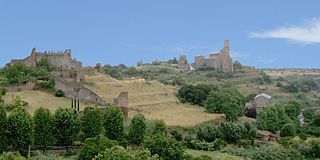
The House of Orsini is an Italian noble family that was one of the most influential princely families in medieval Italy and Renaissance Rome. Members of the Orsini family include five popes: Stephen II (752–757), Paul I (757–767), Celestine III (1191–1198), Nicholas III (1277–1280), and Benedict XIII (1724–1730). The family also included 34 cardinals, numerous condottieri, and other significant political and religious figures. The Orsini are part of the Black nobility who were Roman aristocratic families who supported the Popes in the governance of the Papal States.

Pope Lucius II, born Gherardo Caccianemici dal Orso, was head of the Catholic Church and ruler of the Papal States from 9 March 1144 to his death in 1145. His pontificate was notable for the unrest in Rome associated with the Commune of Rome and its attempts to wrest control of the city from the papacy. He supported Empress Matilda's claim to England in the Anarchy, and had a tense relationship with King Roger II of Sicily.

Viterbo is a city and comune (municipality) in the Lazio region of Italy, the capital of the province of Viterbo.

Federico da Montefeltro, also known as Federico III da Montefeltro KG, was one of the most successful mercenary captains (condottieri) of the Italian Renaissance, and lord of Urbino from 1444 until his death. A renowned intellectual humanist and civil leader in Urbino on top of his impeccable reputation for martial skill and honour, he commissioned the construction of a great library, perhaps the largest of Italy after the Vatican, with his own team of scribes in his scriptorium, and assembled around him a large humanistic court in the Ducal Palace, Urbino, designed by Luciano Laurana and Francesco di Giorgio Martini.

Sutri is an Ancient town, modern comune and former bishopric in the province of Viterbo, about 50 kilometres (31 mi) from Rome and about 30 kilometres (19 mi) south of Viterbo. It is picturesquely situated on a narrow tuff hill, surrounded by ravines, a narrow neck on the west alone connecting it with the surrounding country. It is one of I Borghi più belli d'Italia.

Sigismondo Pandolfo Malatesta was an Italian condottiero and nobleman, a member of the House of Malatesta and lord of Rimini and Fano from 1432. He was widely considered by his contemporaries as one of the most daring military leaders in Italy and commanded the Venetian forces in the 1465 campaign against the Ottoman Empire. He was also a poet and patron of the arts.

The House of Farnese was an influential family in Renaissance Italy. The titles of Duke of Parma and Piacenza and Duke of Castro were held by various members of the family.

Vetralla is a town and comune in the province of Viterbo, in central Italy, 11 kilometres (7 mi) south of that city, located on a shoulder of Monte Fogliano.

Tuscania is a town and comune in the province of Viterbo, Lazio Region, Italy. Until the late 19th century the town was known as Toscanella.

Ronciglione is a comune in the province of Viterbo, in the Italian region of Latium, about 20 kilometres (12 mi) from Viterbo. The city is located in the Cimini mountains, over two tuff scarps, on the southeastern slope of the former volcano crater now housing Lake Vico.

Roberto Malatesta was an Italian condottiero, or mercenary captain, lord of Rimini, and a member of the House of Malatesta.
Carlo I Malatesta was an Italian condottiero during the Wars in Lombardy and lord of Rimini, Fano, Cesena and Pesaro. He was a member of the powerful House of Malatesta. Carlo's wife was Elisabetta Gonzaga; they were married in November 1386. Francesco I Gonzaga married Carlo's sister Margherita Malatesta in 1393, cementing ties between the families. Carlo was the brother of Pandolfo III and Andrea Malatesta, with whom he fought in numerous occasions.
Malatesta II Malatesta, best known as Guastafamiglia was an Italian condottiero and lord of Rimini.

Everso II degli Anguillara was an Italian condottiero, a member of the Anguillara family.
Giovanni di Vico was an Italian Ghibelline leader, lord of Viterbo, Vetralla, Orvieto, Narni and numerous other lands in northern Lazio and Umbria. He is the most famous member of the Prefetti di Vico family.

Niccolò Fortebraccio (1375–1435), also known as Niccolò della Stella, was an Italian condottiero.

Napoleone Orsini was an Italian condottiero.
Tiburzio di Maso was a leader of an anarchic faction in Rome that briefly attempted to restore the medieval commune of the city, the last attempt at populist government in the States of the Church.
Galeotto I Malatesta (1299–1385) was an Italian condottiero from the House of Malatesta who was lord of Rimini, Fano, Ascoli Piceno, Cesena and Fossombrone.

The 1280–81 papal election elected Simon de Brion, who took the name Pope Martin IV, as the successor to Pope Nicholas III.















